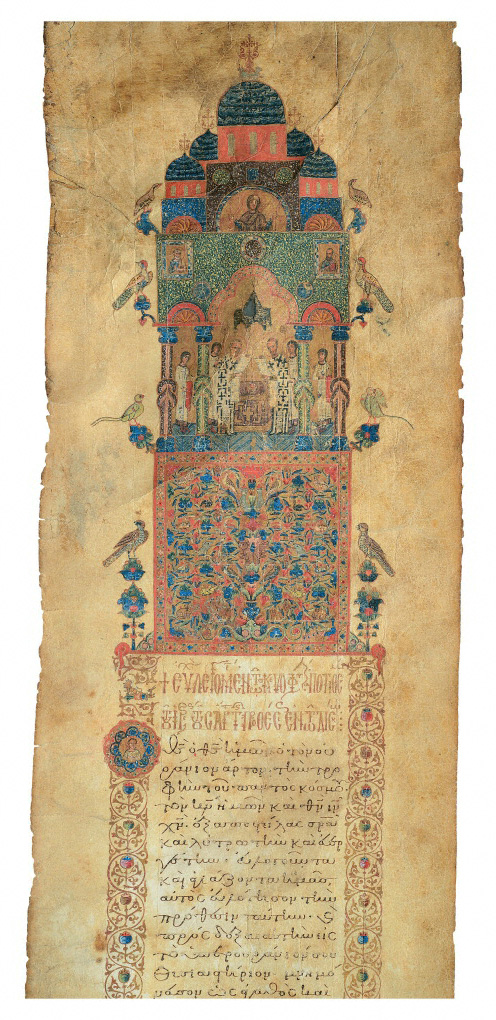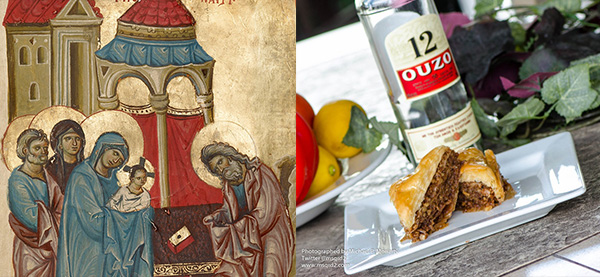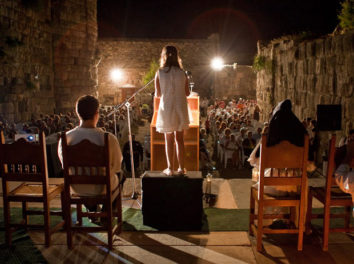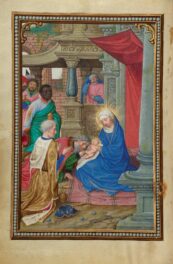It’s a fitting day to celebrate Greek culture with illuminated manuscripts—and baklava

The Divine Liturgy of Saint Basil in a liturgical scroll, made in Vermion, 1100s. Parchment, 26 x 10 in. Image courtesy of the National Library of Greece, Athens, cod 2759
As a museum curator, the idea of combining baklava, a sticky-sweet Greek dessert, and priceless Byzantine manuscripts should make me shudder. But today, March 25, is Greece’s Independence Day, when Greeks traditionally celebrate with baklava and ouzo. Fittingly, it is also the opening day of the Getty Center exhibition Heaven and Earth: Byzantine Illumination at the Cultural Crossroads, featuring six magnificent manuscripts generously lent by institutions in Greece.

Saint John in a Gospel book, made in Serres, 1418. Leaf, 8 11/16 x 6 5/16 in. Athens, National Library of Greece, Cod. 2603, fol. 269v
The Byzantine Empire (A.D. 330–1453) originally comprised Greece and Asia Minor (known today as Turkey). Its manuscripts, shimmering with gold and infused with a deeply spiritual aura, were renowned throughout the empire and beyond. The six manuscripts from Greece are supplemented in the exhibition by eleven manuscripts from the Getty Museum’s permanent collection in order to explore the beauty of Byzantine illumination and its enduring influence in places as far-flung as Germany, Armenia, and Ethiopia.

Left: Decorated Text Page, leaf from a Gospel lectionary, possibly made in Constantinople, A.D. 500s. Parchment, 12 3/16 x 10 5/8 in. Thessaloniki, Museum of Byzantine Culture, inv BChPh 1. Image courtesy of the Museum of Byzantine Culture. Right: Decorated Text Page, leaf from a Gospel lectionary, made in the Rhine-Meuse region, early 800s. The J. Paul Getty Museum, Ms. Ludwig IV 1, leaf 2v
The most exciting moment in the process of putting the exhibition together came for me last week, when the Greek objects that I had been studying for over a year finally arrived at the Getty Center. To see a purple-dyed parchment leaf from the sixth century emerge out of its careful wrappings was a moment I will treasure as among the most memorable of my career. This object, with its text written in gold and silver leaf, created for the imperial family of the Byzantine emperor, has already survived for 1,500 years, and now it graces the galleries of the Getty for a limited time. How amazing is that?
In the exhibition, we pair this page with a leaf from a European manuscript created under the reign of the Holy Roman Emperor Charlemagne in the early 800s. The manuscript was intended to call forth in the viewer’s mind the tradition of lavish imperial Byzantine manuscripts. In reality it was a kind of medieval knock-off—the parchment was likely not dyed purple, but rather painted to resemble this expensive technique, and the script was not written in silver leaf, but rather brass, a less costly alternative. (This discovery by Nancy Turner, the Getty Museum’s conservator of manuscripts, will be published in more detail in the future.)

Left: Saint Luke in a Gospel book, made in Constantinople, about 1050–75. Parchment, 10 1/16 x 7 11/16 x 2 1/2 in. Image courtesy of the National Library of Greece, Athens, Cod. 57, fol. 167v. Right: Saint Luke in a Gospel book, made in Ethiopia, about 1480–1520. Parchment, 13 9/16 x 10 1/16 in. The J. Paul Getty Museum, Ms. 105, fol. 116v
Another comparison, one that demonstrates Byzantine influence on medieval eastern Christian art, are these two illuminations of Saint Luke, one created in 11th-century Greece and the other in late 15th-century Ethiopia. The composition of the Ethiopian image is clearly based on Byzantine models, but while the Byzantine artist used naturalistic forms in rendering the saint’s form and surroundings, the Ethiopian artist has energized his composition with abstract shapes and colors. So although the scenes differ in their overall aesthetic, the Ethiopian manuscript testifies to Byzantine illumination’s continued resonance with later artists in varied regions.

Left: Saint John in a Gospel book, made in Malesina, mid-1300s. Parchment, 11 x 7 7/8 x 4 in. Image courtesy of the National Library of Greece, Athens, Cod. 150, fol. 166v. Right (from the exhibition at the Getty Villa): Apostle Andreas (mosaic decoration), Greek, late 1000s–early 1100s, Greek. Stone and glass tesserae on plaster, 69 5/16 x 39 3/4 in. Image courtesy of the Archaeological Museum, Serres, no. 15
The Getty Center exhibition, which I curated with Dr. Justine Andrews of the University of New Mexico, was developed in concert with an exhibition opening at the Getty Villa on April 9, Heaven and Earth: Art of Byzantium from Greek Collections. The Villa exhibition features 167 objects, including mosaics, icons, frescoes, sculptures, metalwork, jewelry, glass, embroideries, and ceramics, coming from over thirty collections throughout Greece. Together, the two exhibitions offer the largest and most important collection of Byzantine art ever to be presented in Los Angeles.

Left: The Presentation in the Temple (detail) in a Gospel book, made in Nicaea or Nicomedia, late 1200s. The J. Paul Getty Museum, Ms. Ludwig II 5, fol. 129v. Right: Baklava and ouzo. Photo by Michael P. Moriarty
So please come to the Getty Center to enjoy the allure, power, and majesty of Byzantine manuscripts—perhaps as a perfect appetizer to a treat of baklava and ouzo at one of our city’s wonderful Greek restaurants. You can see these treasures at the Getty Center any day until June 22 (although I don’t suggest ouzo every day between now and then).




Comments on this post are now closed.